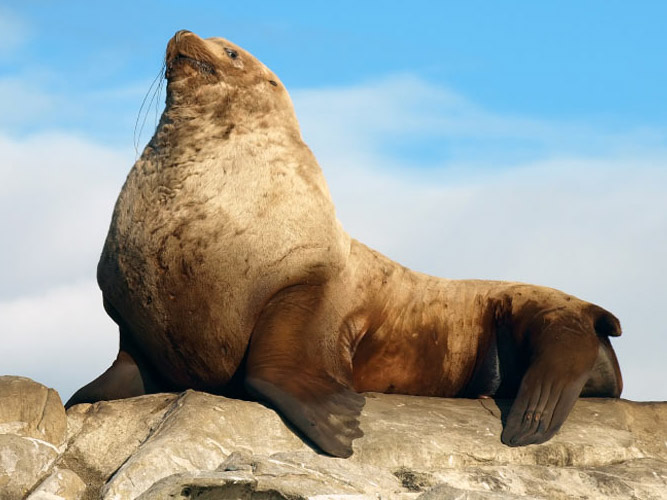
When we think of sea lions, the playful bark of the California variety often comes to mind. But lurking in the colder, nutrient-rich waters of the North Pacific is a truly magnificent beast – the Steller Sea Lion (Eumetopias jubatus). These are the largest of all sea lion species, true titans of the ocean that command respect with their immense size and powerful presence.
A Gentle Giant (Mostly)
Adult male Steller Sea Lions are particularly imposing, often weighing over 2,000 pounds and reaching lengths of nearly 11 feet! Females are considerably smaller but still impressive, typically weighing between 500 and 800 pounds. Their fur ranges from a light tan to a reddish-brown, often appearing lighter when dry. Pups, born on remote rookeries, are a much darker brown, almost black, and are utterly adorable with their large, dark eyes.
Unlike the boisterous California Sea Lions, Stellers are generally less vocal, though males do have a distinctive, deep roar during the breeding season that echoes across the rocky shores. They’re also less prone to “hauling out” on man-made structures like piers, preferring the rugged, isolated coastlines and islands that define their habitat.
Where in the World Are They?
The range of the Steller Sea Lion spans the vast North Pacific Ocean. You’ll find them from the coasts of Japan and Russia, across the Bering Sea, through Alaska and British Columbia, and down to occasional sightings in Washington, Oregon, and Northern California. They prefer cooler, productive waters, where their primary food sources – a diverse diet of fish like pollock, cod, and herring, as well as octopus and squid – are abundant.
Their life revolves around specific haul-out sites and breeding rookeries. These are often remote, windswept islands or rocky outcrops, providing safety from terrestrial predators and disturbance.
A Troubled Past and Hope for the Future
Sadly, the story of the Steller Sea Lion is one of both majesty and struggle. During the latter half of the 20th century, their populations experienced a dramatic and alarming decline, particularly in the western part of their range (Alaska and Russia). This led to them being listed as an endangered species in the U.S., prompting intensive research and conservation efforts.
While the exact causes of the decline are complex and still debated, factors like:
- Reduced food availability: Potentially linked to large-scale commercial fishing operations.
- Predation: By killer whales.
- Environmental changes: Affecting their prey base.
All likely played a role.
The good news is that thanks to dedicated conservation efforts, including fisheries management, habitat protection, and reduced direct human disturbance, the population trend for Steller Sea Lions has shown signs of recovery in some areas. The U.S. population has been divided into an “eastern distinct population segment” (which has largely recovered and was delisted from the Endangered Species Act) and a “western distinct population segment” (which remains endangered). This ongoing recovery is a testament to what can be achieved with focused scientific research and conservation action.
Observing the King of the Pinnipeds
Spotting a Steller Sea Lion in the wild is a truly awe-inspiring experience. Their sheer size and wild nature are captivating. If you’re traveling along the coasts of Alaska, British Columbia, or the Pacific Northwest, keep an eye out for these magnificent creatures on rocky shores, buoys, or even just their distinctive, large heads bobbing in the waves.
The Steller Sea Lion is a powerful reminder of the raw beauty and resilience of marine wildlife, and the ongoing importance of protecting our oceans for all their inhabitants.
Keep exploring:
- A Deep Dive into the Wonderful World of Sea Lions
- Sea Lions vs Seals: Unraveling the Mystery of Pinnipeds
- Steller Sea Lion | NOAA Fisheries
- Steller Sea Lion | The Marine Mammal Center
- Steller Sea Lion (Eumetopias jubatus) | Alaska Department of Fish and Game
- Steller Sea Lion | National Park Service
- Steller Sea Lion Decline | National Park Service
- The “Steller” Success Story of a Sea Lion Population | NOAA Fisheries
More photos below ↓












Disclaimer: This blog post is for edutainment purposes only and may not be entirely accurate.






